window FIAT 500C 2016 2.G Owner's Guide
[x] Cancel search | Manufacturer: FIAT, Model Year: 2016, Model line: 500C, Model: FIAT 500C 2016 2.GPages: 442, PDF Size: 3.1 MB
Page 292 of 442
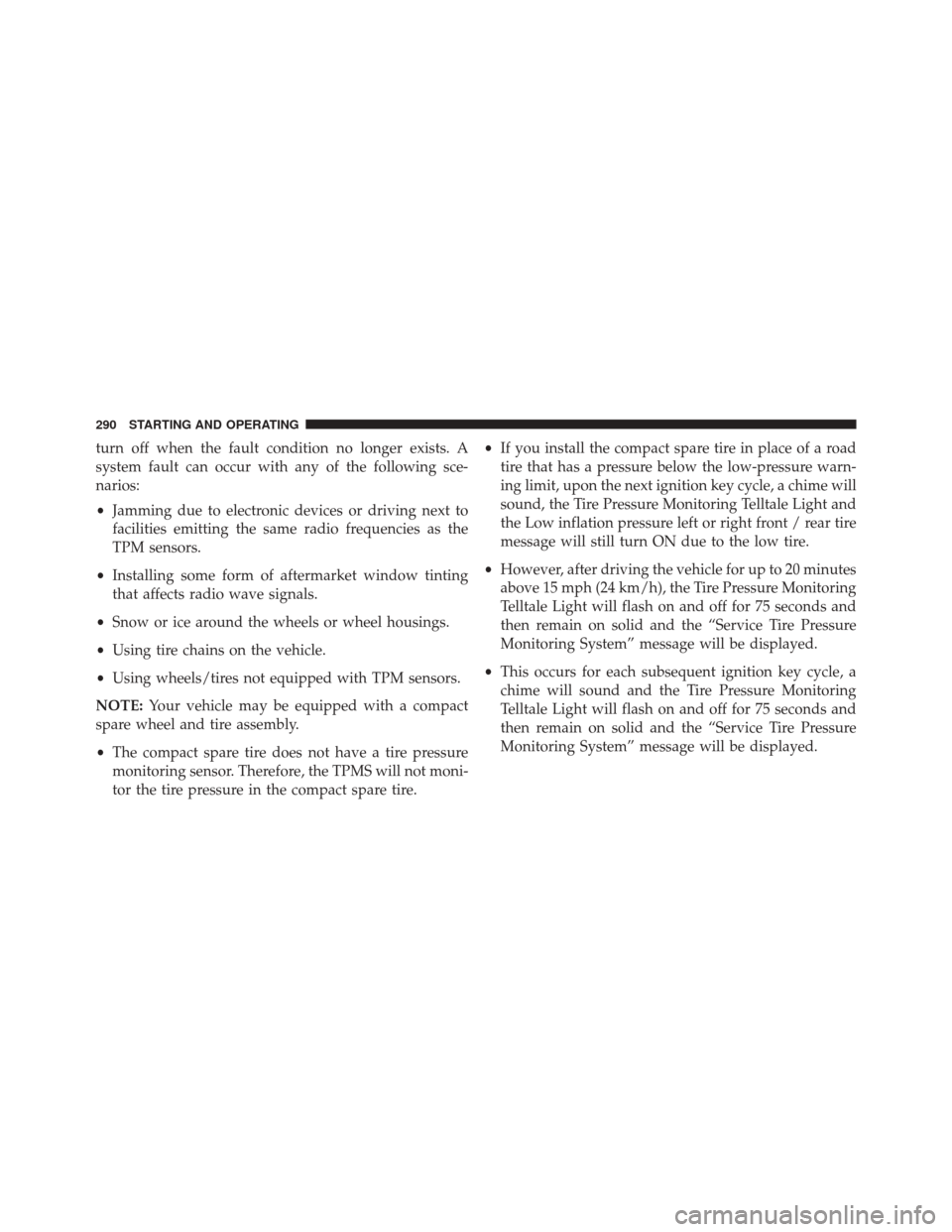
turn off when the fault condition no longer exists. A
system fault can occur with any of the following sce-
narios:
•Jamming due to electronic devices or driving next to
facilities emitting the same radio frequencies as the
TPM sensors.
• Installing some form of aftermarket window tinting
that affects radio wave signals.
• Snow or ice around the wheels or wheel housings.
• Using tire chains on the vehicle.
• Using wheels/tires not equipped with TPM sensors.
NOTE: Your vehicle may be equipped with a compact
spare wheel and tire assembly.
• The compact spare tire does not have a tire pressure
monitoring sensor. Therefore, the TPMS will not moni-
tor the tire pressure in the compact spare tire. •
If you install the compact spare tire in place of a road
tire that has a pressure below the low-pressure warn-
ing limit, upon the next ignition key cycle, a chime will
sound, the Tire Pressure Monitoring Telltale Light and
the Low inflation pressure left or right front / rear tire
message will still turn ON due to the low tire.
• However, after driving the vehicle for up to 20 minutes
above 15 mph (24 km/h), the Tire Pressure Monitoring
Telltale Light will flash on and off for 75 seconds and
then remain on solid and the “Service Tire Pressure
Monitoring System” message will be displayed.
• This occurs for each subsequent ignition key cycle, a
chime will sound and the Tire Pressure Monitoring
Telltale Light will flash on and off for 75 seconds and
then remain on solid and the “Service Tire Pressure
Monitoring System” message will be displayed.
290 STARTING AND OPERATING
Page 295 of 442
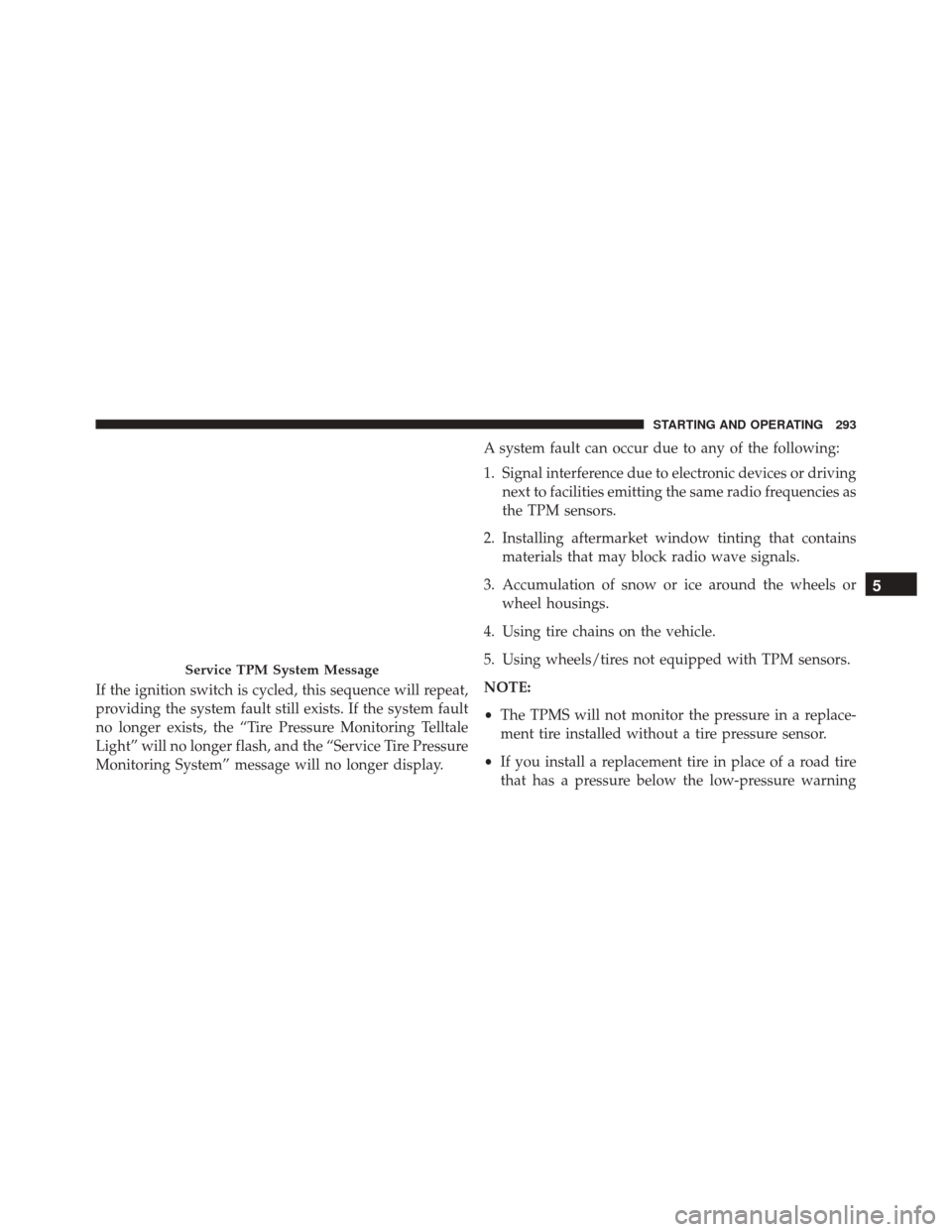
If the ignition switch is cycled, this sequence will repeat,
providing the system fault still exists. If the system fault
no longer exists, the “Tire Pressure Monitoring Telltale
Light” will no longer flash, and the “Service Tire Pressure
Monitoring System” message will no longer display.A system fault can occur due to any of the following:
1. Signal interference due to electronic devices or driving
next to facilities emitting the same radio frequencies as
the TPM sensors.
2. Installing aftermarket window tinting that contains materials that may block radio wave signals.
3. Accumulation of snow or ice around the wheels or wheel housings.
4. Using tire chains on the vehicle.
5. Using wheels/tires not equipped with TPM sensors.
NOTE:
• The TPMS will not monitor the pressure in a replace-
ment tire installed without a tire pressure sensor.
• If you install a replacement tire in place of a road tire
that has a pressure below the low-pressure warning
Service TPM System Message
5
STARTING AND OPERATING 293
Page 301 of 442
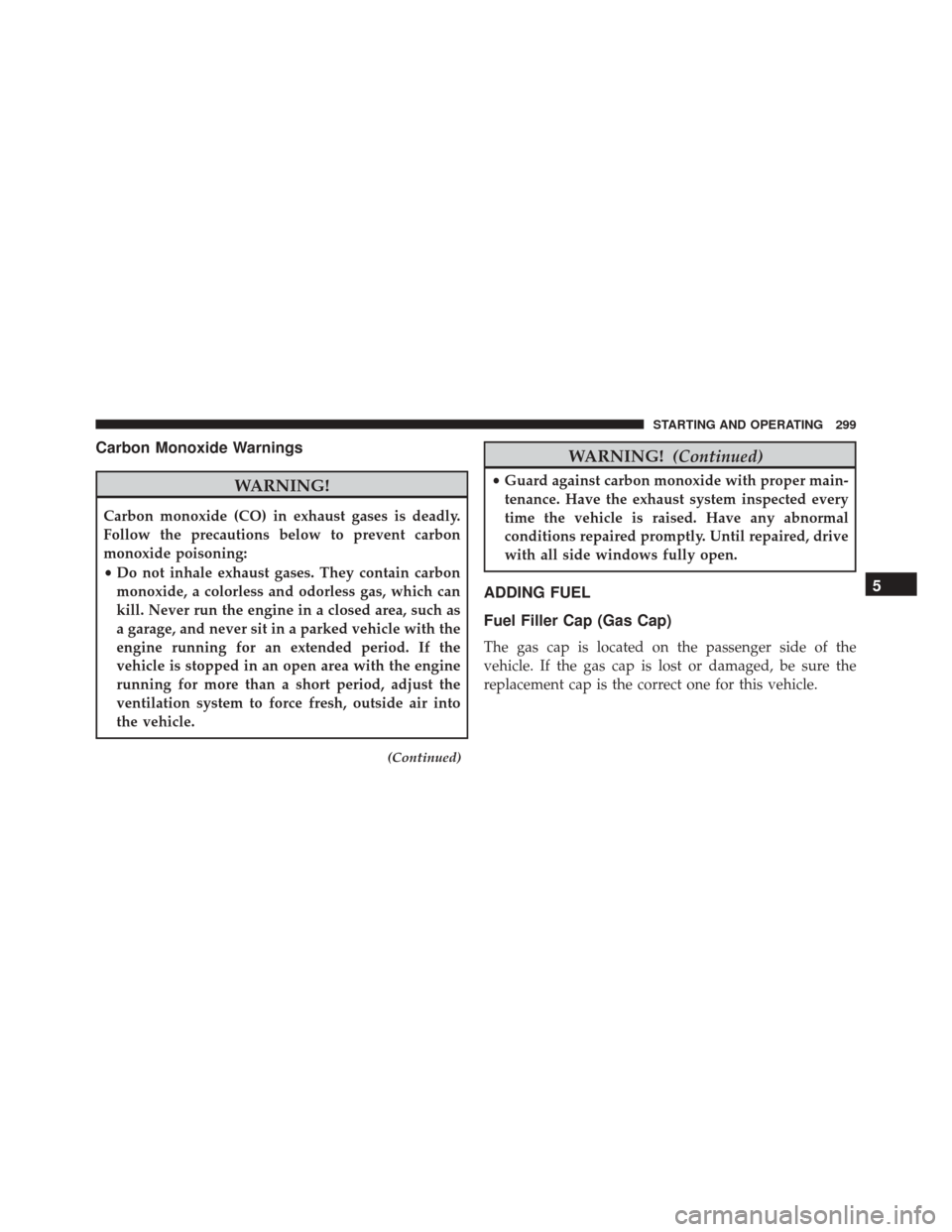
Carbon Monoxide Warnings
WARNING!
Carbon monoxide (CO) in exhaust gases is deadly.
Follow the precautions below to prevent carbon
monoxide poisoning:
•Do not inhale exhaust gases. They contain carbon
monoxide, a colorless and odorless gas, which can
kill. Never run the engine in a closed area, such as
a garage, and never sit in a parked vehicle with the
engine running for an extended period. If the
vehicle is stopped in an open area with the engine
running for more than a short period, adjust the
ventilation system to force fresh, outside air into
the vehicle.
(Continued)
WARNING! (Continued)
•Guard against carbon monoxide with proper main-
tenance. Have the exhaust system inspected every
time the vehicle is raised. Have any abnormal
conditions repaired promptly. Until repaired, drive
with all side windows fully open.
ADDING FUEL
Fuel Filler Cap (Gas Cap)
The gas cap is located on the passenger side of the
vehicle. If the gas cap is lost or damaged, be sure the
replacement cap is the correct one for this vehicle.
5
STARTING AND OPERATING 299
Page 366 of 442
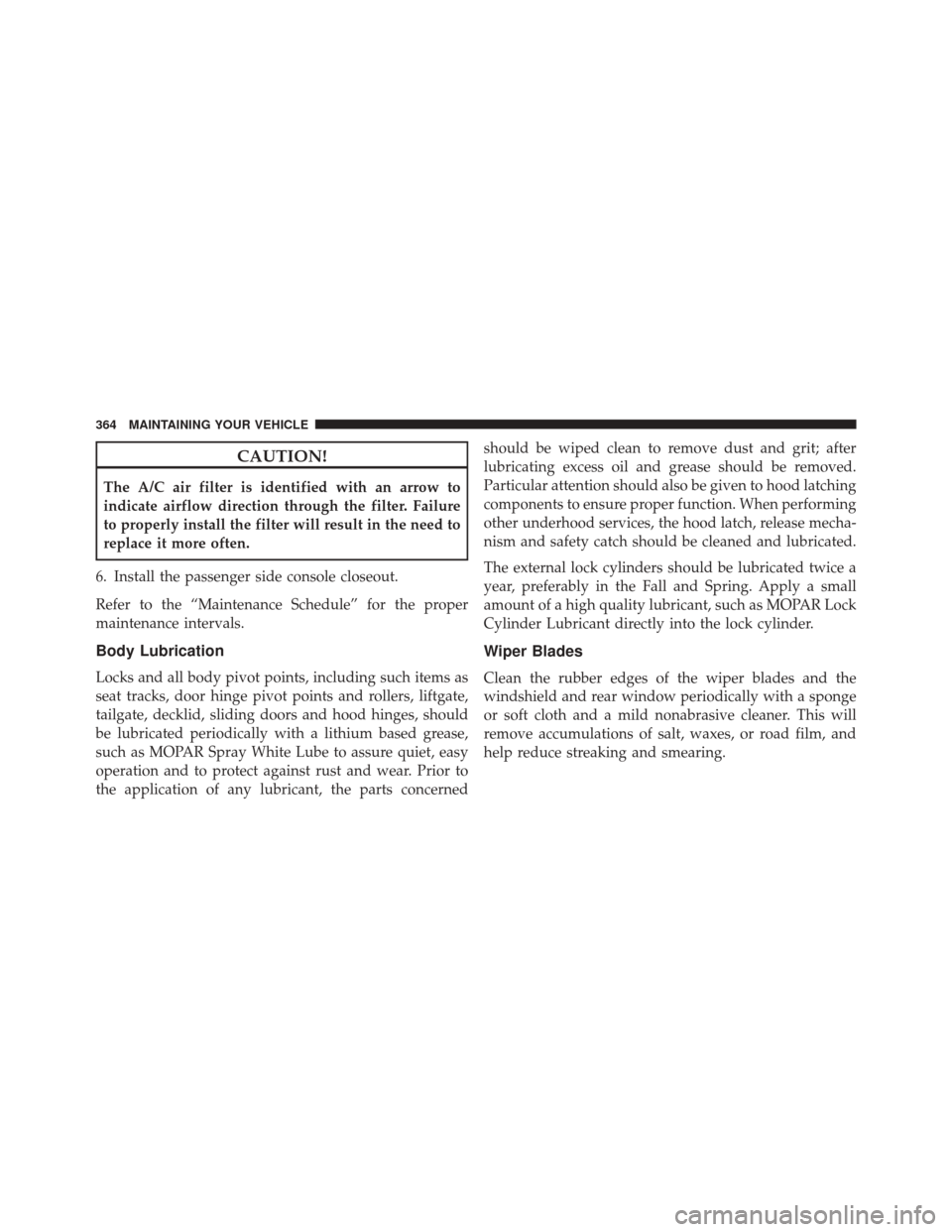
CAUTION!
The A/C air filter is identified with an arrow to
indicate airflow direction through the filter. Failure
to properly install the filter will result in the need to
replace it more often.
6. Install the passenger side console closeout.
Refer to the “Maintenance Schedule” for the proper
maintenance intervals.
Body Lubrication
Locks and all body pivot points, including such items as
seat tracks, door hinge pivot points and rollers, liftgate,
tailgate, decklid, sliding doors and hood hinges, should
be lubricated periodically with a lithium based grease,
such as MOPAR Spray White Lube to assure quiet, easy
operation and to protect against rust and wear. Prior to
the application of any lubricant, the parts concerned should be wiped clean to remove dust and grit; after
lubricating excess oil and grease should be removed.
Particular attention should also be given to hood latching
components to ensure proper function. When performing
other underhood services, the hood latch, release mecha-
nism and safety catch should be cleaned and lubricated.
The external lock cylinders should be lubricated twice a
year, preferably in the Fall and Spring. Apply a small
amount of a high quality lubricant, such as MOPAR Lock
Cylinder Lubricant directly into the lock cylinder.
Wiper Blades
Clean the rubber edges of the wiper blades and the
windshield and rear window periodically with a sponge
or soft cloth and a mild nonabrasive cleaner. This will
remove accumulations of salt, waxes, or road film, and
help reduce streaking and smearing.
364 MAINTAINING YOUR VEHICLE
Page 367 of 442
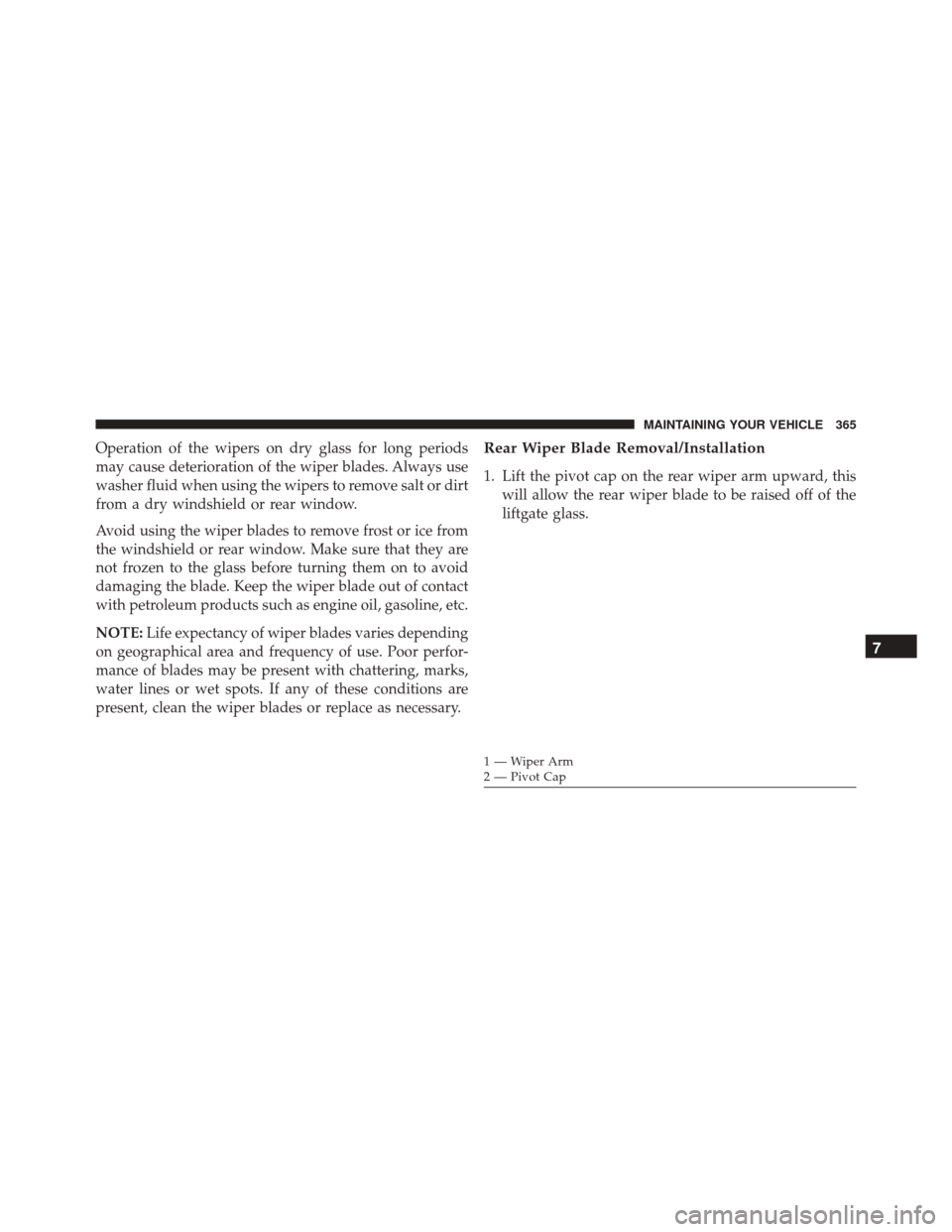
Operation of the wipers on dry glass for long periods
may cause deterioration of the wiper blades. Always use
washer fluid when using the wipers to remove salt or dirt
from a dry windshield or rear window.
Avoid using the wiper blades to remove frost or ice from
the windshield or rear window. Make sure that they are
not frozen to the glass before turning them on to avoid
damaging the blade. Keep the wiper blade out of contact
with petroleum products such as engine oil, gasoline, etc.
NOTE:Life expectancy of wiper blades varies depending
on geographical area and frequency of use. Poor perfor-
mance of blades may be present with chattering, marks,
water lines or wet spots. If any of these conditions are
present, clean the wiper blades or replace as necessary.Rear Wiper Blade Removal/Installation
1. Lift the pivot cap on the rear wiper arm upward, this will allow the rear wiper blade to be raised off of the
liftgate glass.
1 — Wiper Arm
2 — Pivot Cap
7
MAINTAINING YOUR VEHICLE 365
Page 387 of 442
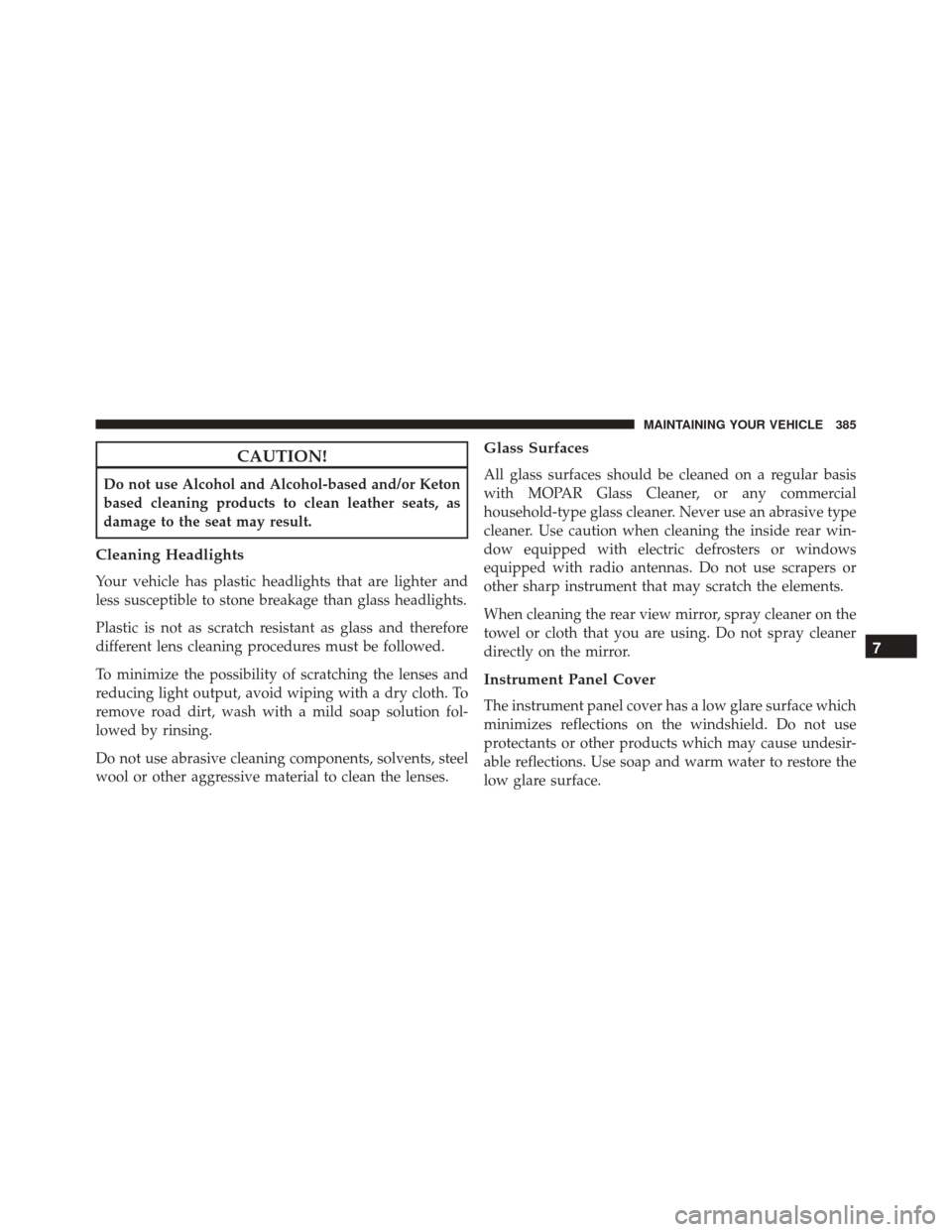
CAUTION!
Do not use Alcohol and Alcohol-based and/or Keton
based cleaning products to clean leather seats, as
damage to the seat may result.
Cleaning Headlights
Your vehicle has plastic headlights that are lighter and
less susceptible to stone breakage than glass headlights.
Plastic is not as scratch resistant as glass and therefore
different lens cleaning procedures must be followed.
To minimize the possibility of scratching the lenses and
reducing light output, avoid wiping with a dry cloth. To
remove road dirt, wash with a mild soap solution fol-
lowed by rinsing.
Do not use abrasive cleaning components, solvents, steel
wool or other aggressive material to clean the lenses.
Glass Surfaces
All glass surfaces should be cleaned on a regular basis
with MOPAR Glass Cleaner, or any commercial
household-type glass cleaner. Never use an abrasive type
cleaner. Use caution when cleaning the inside rear win-
dow equipped with electric defrosters or windows
equipped with radio antennas. Do not use scrapers or
other sharp instrument that may scratch the elements.
When cleaning the rear view mirror, spray cleaner on the
towel or cloth that you are using. Do not spray cleaner
directly on the mirror.
Instrument Panel Cover
The instrument panel cover has a low glare surface which
minimizes reflections on the windshield. Do not use
protectants or other products which may cause undesir-
able reflections. Use soap and warm water to restore the
low glare surface.
7
MAINTAINING YOUR VEHICLE 385
Page 389 of 442
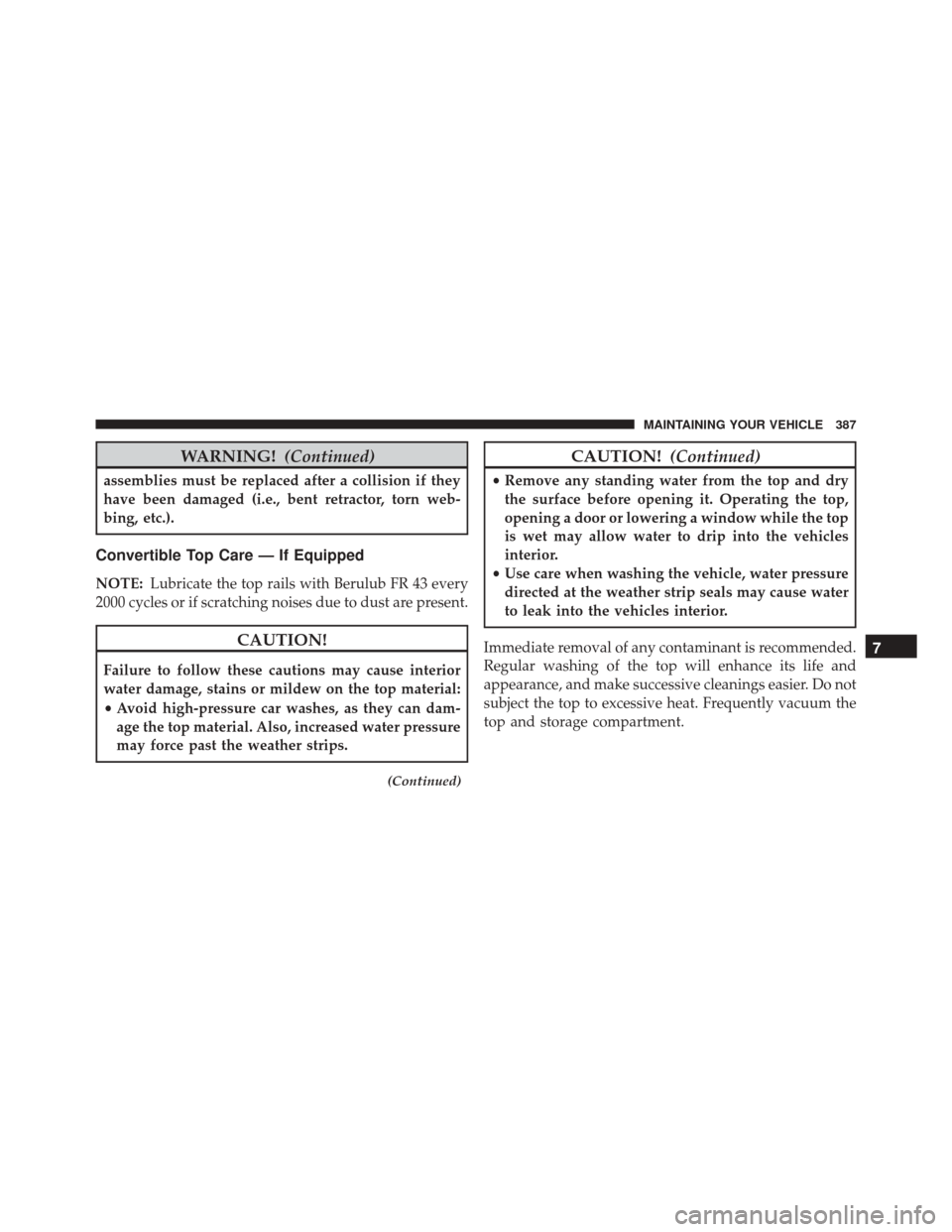
WARNING!(Continued)
assemblies must be replaced after a collision if they
have been damaged (i.e., bent retractor, torn web-
bing, etc.).
Convertible Top Care — If Equipped
NOTE:Lubricate the top rails with Berulub FR 43 every
2000 cycles or if scratching noises due to dust are present.
CAUTION!
Failure to follow these cautions may cause interior
water damage, stains or mildew on the top material:
• Avoid high-pressure car washes, as they can dam-
age the top material. Also, increased water pressure
may force past the weather strips.
(Continued)
CAUTION! (Continued)
•Remove any standing water from the top and dry
the surface before opening it. Operating the top,
opening a door or lowering a window while the top
is wet may allow water to drip into the vehicles
interior.
• Use care when washing the vehicle, water pressure
directed at the weather strip seals may cause water
to leak into the vehicles interior.
Immediate removal of any contaminant is recommended.
Regular washing of the top will enhance its life and
appearance, and make successive cleanings easier. Do not
subject the top to excessive heat. Frequently vacuum the
top and storage compartment.
7
MAINTAINING YOUR VEHICLE 387
Page 393 of 442
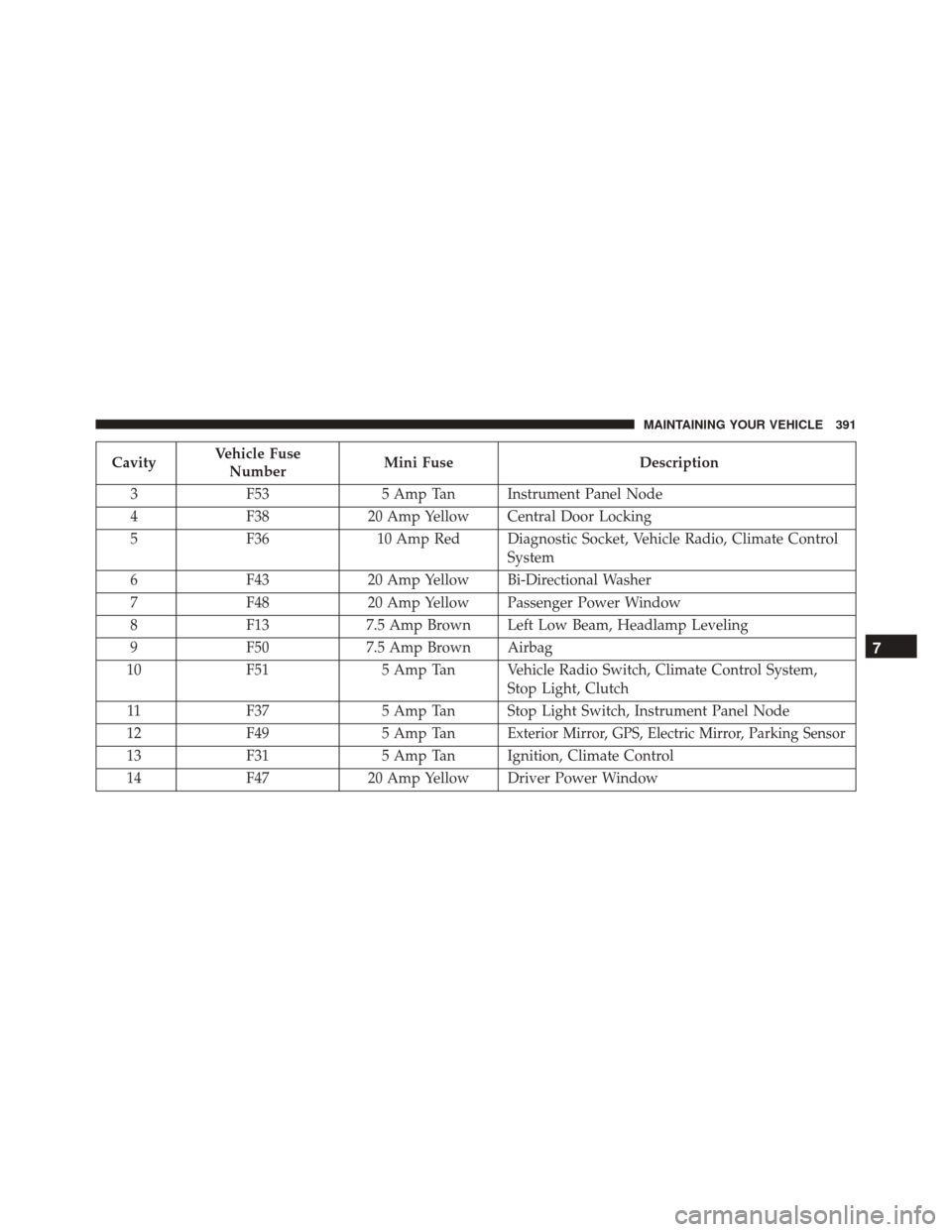
CavityVehicle Fuse
Number Mini Fuse
Description
3 F53 5 Amp Tan Instrument Panel Node
4 F38 20 Amp Yellow Central Door Locking
5 F36 10 Amp Red Diagnostic Socket, Vehicle Radio, Climate Control
System
6 F43 20 Amp Yellow Bi-Directional Washer
7 F48 20 Amp Yellow Passenger Power Window
8 F13 7.5 Amp Brown Left Low Beam, Headlamp Leveling
9 F50 7.5 Amp Brown Airbag
10 F51 5 Amp Tan Vehicle Radio Switch, Climate Control System,
Stop Light, Clutch
11 F37 5 Amp Tan Stop Light Switch, Instrument Panel Node
12 F49 5 Amp Tan
Exterior Mirror, GPS, Electric Mirror, Parking Sensor
13F31 5 Amp Tan Ignition, Climate Control
14 F47 20 Amp Yellow Driver Power Window
7
MAINTAINING YOUR VEHICLE 391
Page 435 of 442
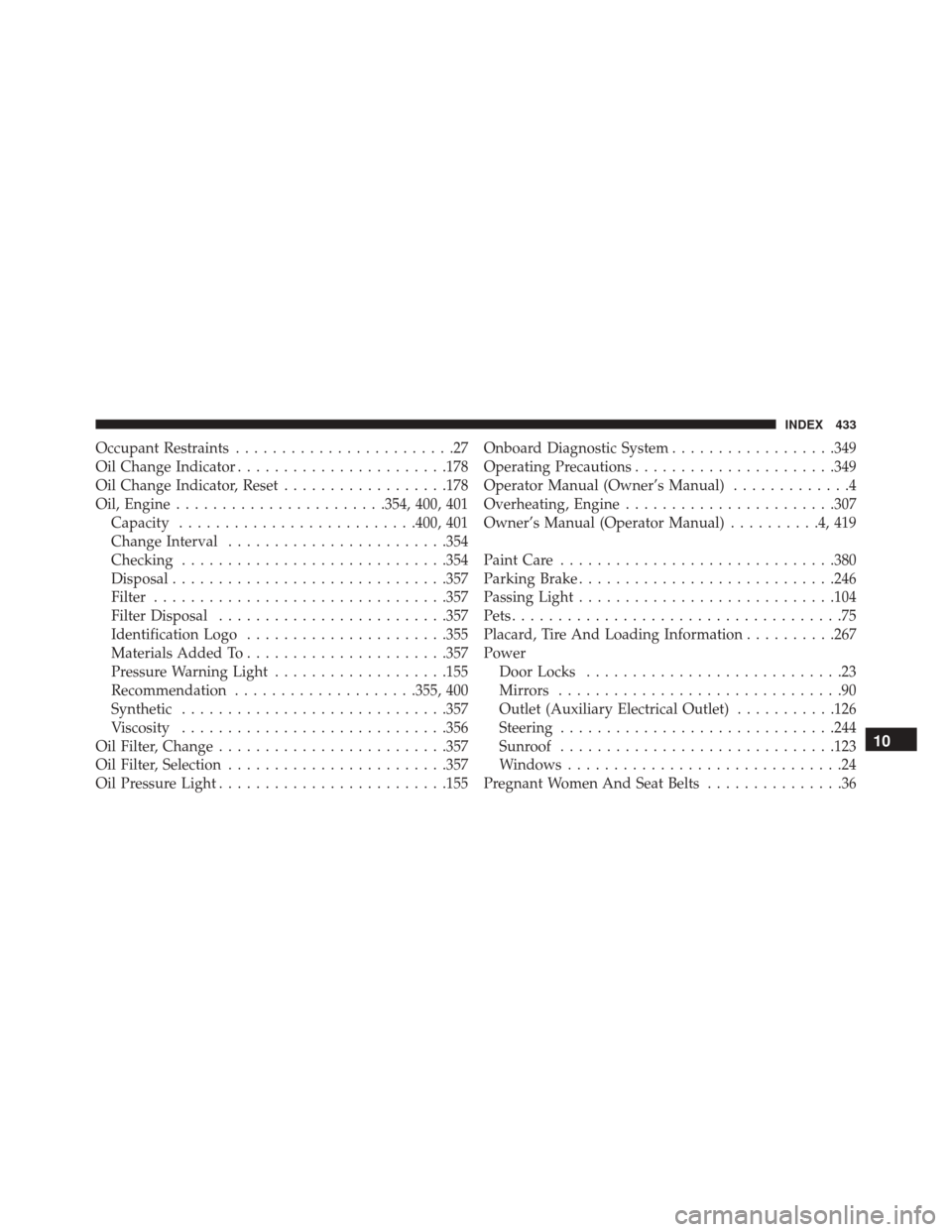
Occupant Restraints........................27
Oil Change Indicator ...................... .178
Oil Change Indicator, Reset ..................178
Oil, Engine ...................... .354, 400, 401
Capacity ......................... .400, 401
Change Interval ....................... .354
Checking ............................ .354
Disposal ............................. .357
Filter ............................... .357
Filter Disposal ........................ .357
Identification Logo ..................... .355
Materials Added To ..................... .357
Pressure Warning Light ...................155
Recommendation ....................355, 400
Synthetic ............................ .357
Viscosity ............................ .356
Oil Filter, Change ........................ .357
Oil Filter, Selection ....................... .357
Oil Pressure Light ........................ .155Onboard Diagnostic System
..................349
Operating Precautions ..................... .349
Operator Manual (Owner’s Manual) .............4
Overheating, Engine ...................... .307
Owner’s Manual (Operator Manual) ..........4,419
Paint Care ............................. .380
Parking Brake ........................... .246
Passing Light ........................... .104
Pets ....................................75
Placard, Tire And Loading Information ..........267
Power Door Locks ............................23
Mirrors ...............................90
Outlet (Auxiliary Electrical Outlet) ...........126
Steering ............................. .244
Sunroof ............................. .123
Windows ..............................24
Pregnant Women And Seat Belts ...............36
10
INDEX 433
Page 436 of 442
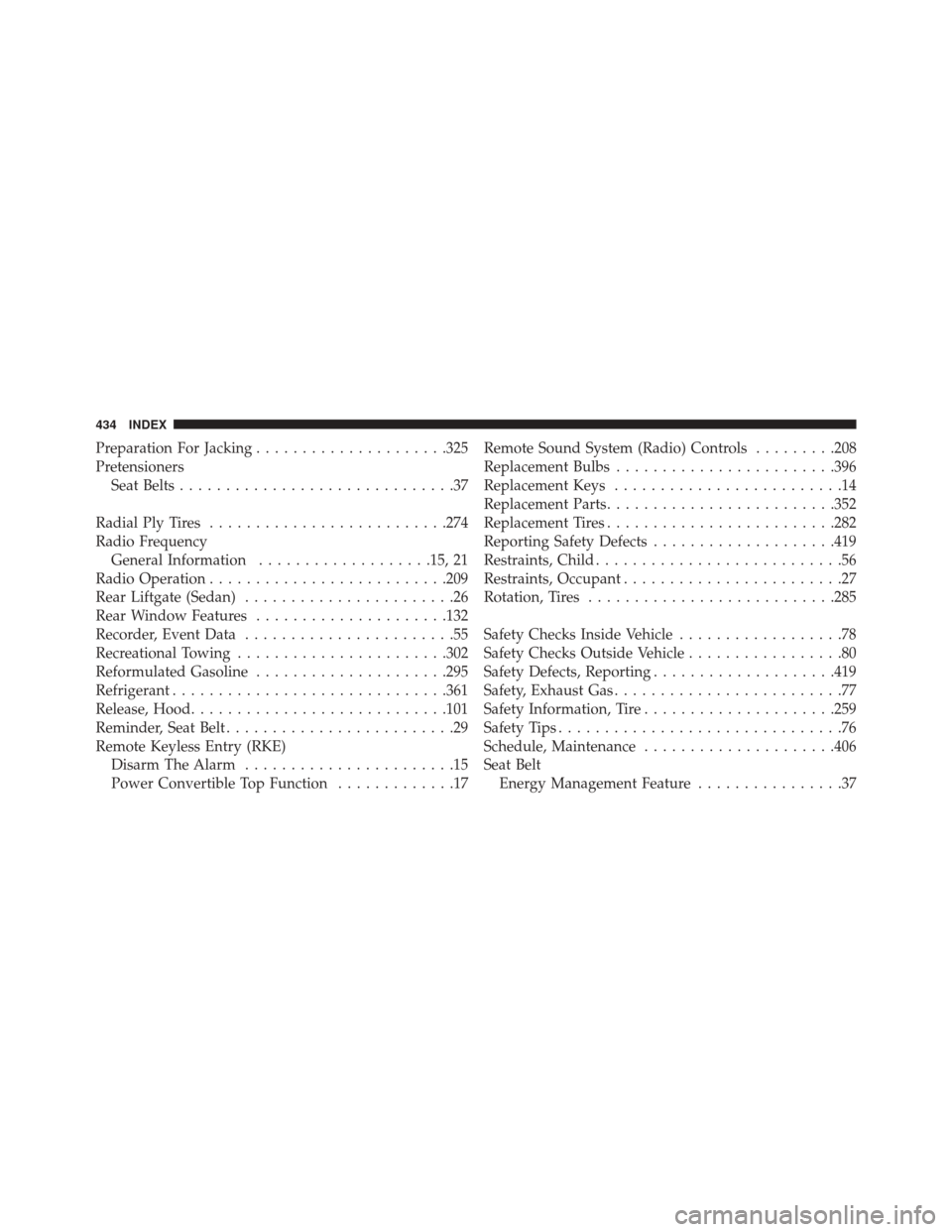
Preparation For Jacking.....................325
Pretensioners Seat Belts ..............................37
Radial Ply Tires ......................... .274
Radio Frequency General Information ...................15, 21
Radio Operation ......................... .209
Rear Liftgate (Sedan) .......................26
Rear Window Features .....................132
Recorder, Event Data .......................55
Recreational Towing ...................... .302
Reformulated Gasoline .....................295
Refrigerant ............................. .361
Release, Hood ........................... .101
Reminder, Seat Belt .........................29
Remote Keyless Entry (RKE) Disarm The Alarm .......................15
Power Convertible Top Function .............17Remote Sound System (Radio) Controls
.........208
Replacement Bulbs ....................... .396
Replacement Keys .........................14
Replacement Parts ........................ .352
Replacement Tires ........................ .282
Reporting Safety Defects ....................419
Restraints, Child ...........................56
Restraints, Occupant ........................27
Rotation, Tires .......................... .285
Safety Checks Inside Vehicle ..................78
Safety Checks Outside Vehicle .................80
Safety Defects, Reporting ....................419
Safety, Exhaust Gas .........................77
Safety Information, Tire .....................259
Safety Tips ...............................76
Schedule, Maintenance .....................406
Seat Belt Energy Management Feature ................37
434 INDEX